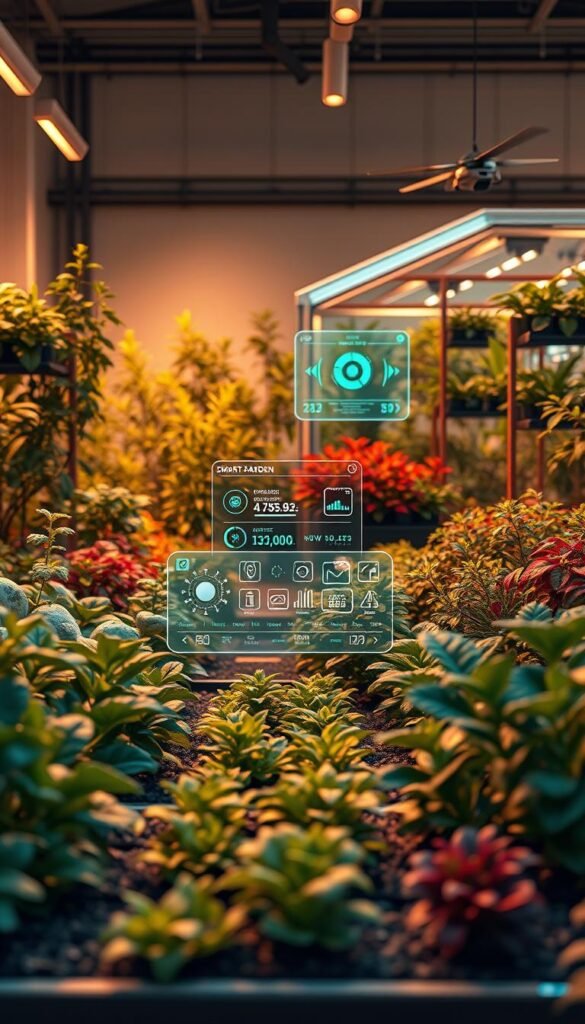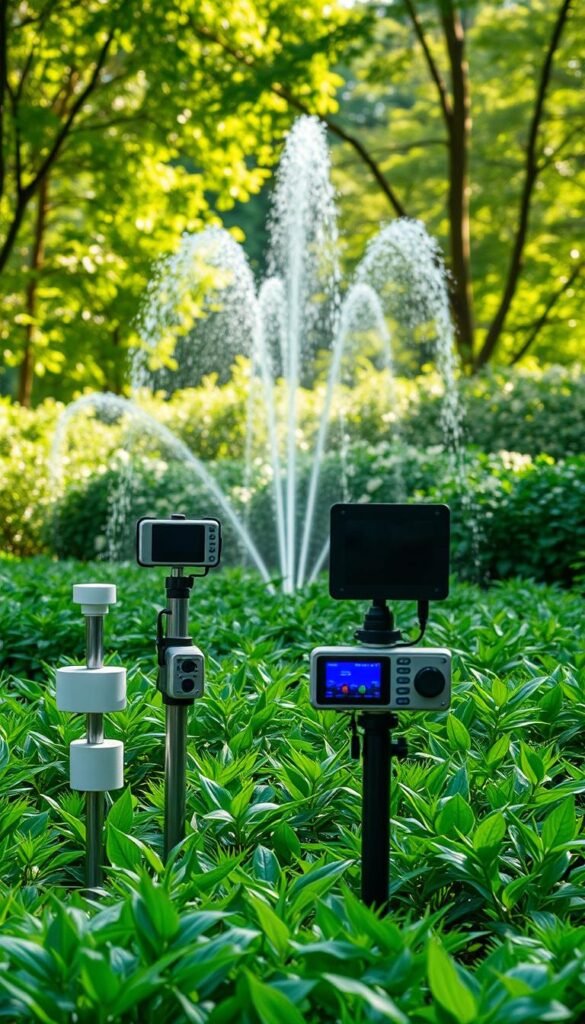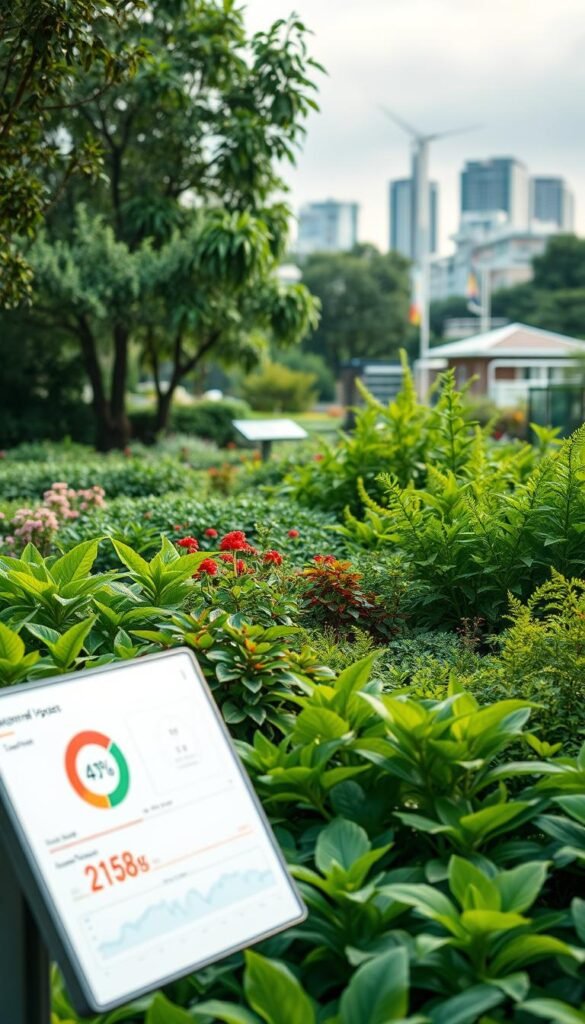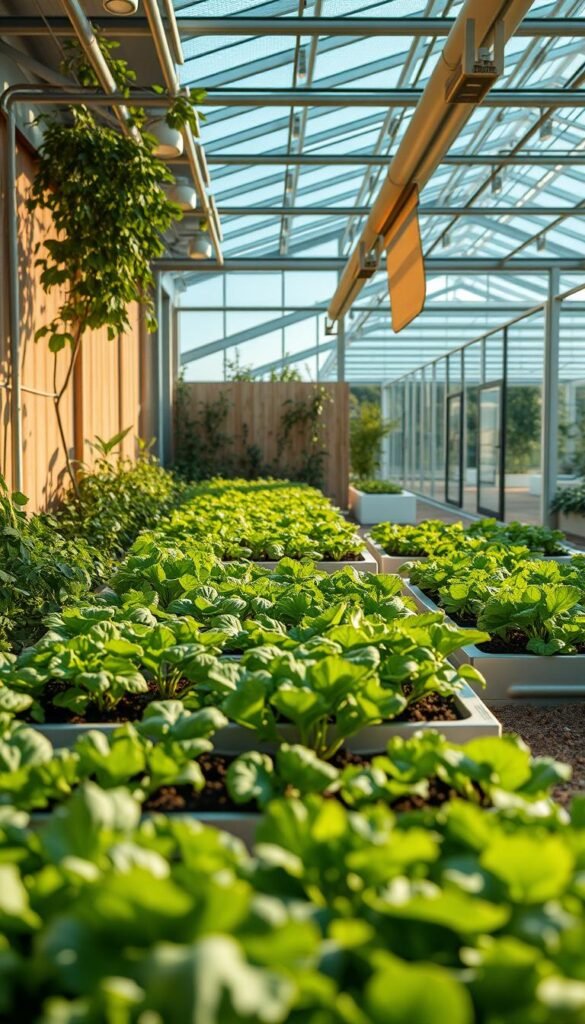Your backyard is getting an upgrade. Gone are the days of guessing when to water plants or worrying about wasted resources. Today’s landscaping blends beauty with brains, creating outdoor spaces that practically care for themselves.
Imagine a yard that adjusts irrigation based on weather forecasts or lights that activate only when needed. These innovations aren’t futuristic dreams—they’re here now. Advanced tools monitor soil moisture, track sunlight patterns, and even detect pests before they become problems.
This shift isn’t just about convenience. Eco-friendly systems help conserve water while boosting plant health. You’ll spend less time maintaining your garden and more time enjoying it. Best part? These solutions work for small patios and sprawling lawns alike.
We’ll show you how to blend practical design with clever tech upgrades. Discover budget-friendly options and premium systems that pay for themselves over time. Ready to transform your green space into a thriving, low-effort oasis? Let’s dig in.
The Evolution of Smart Technology in Garden Design

Today’s outdoor spaces think for themselves. What started as basic sprinkler timers has grown into networks of devices that predict, adapt, and conserve. This shift reshapes how you interact with your yard, blending creativity with data-driven precision.
Tools That Work Smarter, Not Harder
Soil sensors now track hydration levels better than human intuition. GPS-guided mowers map your lawn’s contours, trimming edges with robotic accuracy. These technological advancements eliminate guesswork—your plants get exactly what they need, when they need it.
Remote controls let you adjust irrigation from your phone. Automated systems detect leaks faster than a wandering hose ever could. You’re not just saving time; you’re preventing waste before it happens.
Nature Meets Network
Modern design prioritizes harmony between beauty and function. Weather-responsive systems delay watering when rain’s forecasted. Pollinator-friendly LED lights activate only at dusk, protecting nighttime ecosystems.
The landscaping industry now focuses on solutions that serve both aesthetics and the environment. Drip irrigation targets roots directly, cutting water use by up to 50%. Solar-powered fixtures charge by day, glowing softly after dark without draining resources.
Integrating Smart Technology into Modern Garden Design for Efficiency

Connected devices are revolutionizing how you care for outdoor areas. Imagine soil sensors whispering your plants’ needs to irrigation controllers, while lights sync with sunset times. These tools form an invisible network that keeps your landscape thriving.
Weather-aware sprinklers eliminate overwatering by checking forecasts daily. Paired with root-level moisture detectors, they deliver precise hydration exactly where needed. You’ll see healthier blooms without drowning delicate roots.
Evening illumination does double duty now. Programmable fixtures enhance security while crafting a magical evening atmosphere. Set them to dim automatically at bedtime or brighten when motion appears.
The secret lies in choosing devices that speak the same digital language. Compatibility lets your sprinkler share data with soil probes, creating responsive care cycles. Most kits connect through intuitive apps—adjust settings while sipping morning coffee.
This approach cuts water waste dramatically. One study showed integrated setups reduce outdoor usage by 35% annually. Your plants get tailored attention, and you gain hours previously spent on manual tasks.
Innovative Smart Irrigation Systems for Resource Conservation

Your garden’s thirst just got a tech-savvy solution. Modern irrigation systems now blend precision with environmental awareness, delivering water only when and where it’s needed. These innovations slash waste while keeping plants thriving—no more drowning roses or parched tomatoes.
Real-Time Soil Moisture Monitoring
Gone are the days of poking fingers in dirt to check hydration. Today’s setups use underground probes that track soil moisture levels 24/7. The Rachio 3 Smart Sprinkler Controller pairs with these sensors, skipping scheduled watering when roots are already damp.
For smaller spaces, the Orbit B-hyve Smart Hose Faucet Timer adapts to your garden’s unique needs. It considers plant types and sun exposure, adjusting flow rates like a botanical bartender mixing perfect drinks.
Adaptive Watering Based on Weather Trends
These devices don’t just look downward—they scan the skies too. RainMachine’s touchscreen interface pulls live weather updates, delaying sprinklers if storms approach. You’ll never waste H2O watering before a downpour again.
One California study showed such systems reduce outdoor water use by 12,000 gallons annually per household. That’s enough to fill three swimming pools—or keep your hydrangeas happy through a decade of summers.
Smart Lighting Systems: Enhancing Ambiance and Safety

Light transforms your yard into a living canvas after dark. Modern smart lighting systems let you paint with brightness and color while boosting security. These setups adapt to your lifestyle, turning outdoor spaces into extensions of your living area.
Dynamic Lighting Controls for Outdoor Spaces
Adjust settings with a tap or voice command. Philips Hue’s weatherproof fixtures let you dim pathways for stargazing or brighten dining areas during cookouts. Ring’s motion-activated spots flash when sensors detect movement—startling critters while lighting escape routes.
Energy-Efficient and Aesthetic Solutions
Novostella’s LED flood lights blend practicality with drama. Choose soft amber for intimate gatherings or vibrant hues for birthday bashes. Their app-controlled options use 80% less power than halogen bulbs, cutting bills without sacrificing style.
Program lights to mimic natural cycles. Gradual sunset dimming helps eyes adjust while conserving energy. You’ll create safer outdoor spaces by eliminating dark corners where hazards hide. Bonus: automated schedules make your home look occupied during vacations.
Leveraging IoT and AI for Enhanced Landscape Management

Your plants now have digital guardians. Networks of sensors and algorithms work like botanical bodyguards, monitoring every leaf and root. This landscaping revolution turns guesswork into precise care plans tailored to your yard’s unique DNA.
Data-Driven Insights for Tailored Garden Care
Soil probes and weather stations feed real-time stats to AI platforms. These systems spot patterns humans miss—like subtle pH shifts or early signs of mildew. One user reported catching a beetle infestation 11 days before visible damage appeared.
Your phone becomes a plant doctor’s office. Apps like Tovala Garden send alerts like “Hydrangeas need iron” or “Trim roses before Thursday’s storm.” It’s like having a horticulturist whispering in your ear.
Predictive Maintenance and Automated Adjustments
Machines now anticipate problems before they arise. Smart controllers schedule smart drip irrigation tune-ups when filters clog. Lights dim automatically if energy costs spike during peak hours.
These solutions learn as they work. After three seasons, your setup knows exactly how much shade the magnolia tree provides in July. It adjusts watering zones accordingly—no manual tweaking needed.
You’ll spend less time fixing leaks and more time enjoying blooms. One study showed AI-driven yards require 40% fewer repairs than traditional setups. Your weekends just got sunnier.
Advanced Landscaping Tools and Systems for Improved Safety
Safety meets innovation in today’s landscaping equipment. Cutting-edge tools now shield workers from hazards while streamlining complex tasks. You’ll find machinery that thinks ahead, preventing accidents before they occur through intelligent design.
Automation in Material Handling and Workflow
Modern systems eliminate risky manual processes. The Mulch Mule Trailer’s automated discharge system dumps loads with precision—no more shoveling heavy materials. Its aluminum hopper withstands rough terrain while reducing strain on crews.
Obstacle detection technology acts like a sixth sense for equipment. Sensors halt machinery when objects enter danger zones. Sloped surfaces? Real-time terrain adjustments keep mowers and loaders stable on uneven ground.
Emergency stop features provide instant response during unexpected events. One landscaper shared: “Our tiller shut off automatically when a rock jammed the blades—saved us from costly repairs and potential injury.”
These advancements don’t just protect people. They preserve productivity by minimizing downtime. Automated maintenance alerts ensure tools operate at peak performance, catching issues before they escalate into safety concerns.
Sustainable Practices and Eco-Friendly Innovations in Landscaping
Earth-friendly methods are reshaping how you maintain outdoor spaces. The landscaping industry now prioritizes solutions that protect the environment while delivering stunning results. From solar-powered tools to closed-loop systems, these advances let you create vibrant spaces responsibly.
Green Machinery and Reduced Environmental Footprint
Battery-powered trimmers and mowers are game-changers. Models like EGO’s Power+ series cut noise pollution by 70% compared to gas tools. They eliminate exhaust fumes while maintaining the power needed for tough jobs.
| Feature | Gas Tools | Battery Tools |
|---|---|---|
| Noise Level | 85-95 dB | 65-75 dB |
| Annual CO2 Emissions | 48 lbs | 0 lbs |
| Maintenance Costs | $120/year | $40/year |
Waste Minimization and Smart Resource Use
Composting systems turn clippings into nutrient-rich soil amendments within weeks. Pair them with innovative landscape construction techniques that reuse 90% of onsite materials.
Smart sensors prevent overwatering in urban container gardens and large lawns alike. Solar-powered irrigation pumps slash energy costs while maintaining consistent growth conditions.
These strategies prove sustainability doesn’t mean sacrificing beauty. You’ll reduce waste, conserve resources, and meet client demands for eco-conscious spaces—all while keeping projects profitable.
Trends Shaping the Future of Garden and Landscape Design
A quiet revolution is transforming how you interact with outdoor spaces. Cutting-edge tools now learn your yard’s needs while balancing beauty with environmental care. This shift goes beyond gadgets—it’s redefining what’s possible in landscape design.
Emerging Technologies and Market Growth
Remote-controlled mowers navigate steep slopes while you monitor progress from your porch. AI-powered software like iScape now creates garden design blueprints that factor in microclimates and plant friendships. These innovations aren’t just cool—they’re becoming affordable.
“The average smart irrigation system pays for itself in 14 months through water savings.”
Market analysts predict 22% growth in landscaping technology by 2026. Why? Homeowners want solutions that:
- Automatically adjust to weather changes
- Provide real-time plant health updates
- Integrate seamlessly with home networks
Client Demands and Evolving Industry Standards
Your neighbors aren’t just asking for pretty flowers anymore. Seventy-three percent of clients now prioritize eco-friendly features like rainwater harvesting systems. Professionals must master new skills—from drone mapping to soil analytics.
| Feature | Traditional Systems | Smart Systems |
|---|---|---|
| Water Usage | Fixed schedules | Weather-responsive |
| Maintenance | Weekly checks | Self-diagnosing |
| Adaptability | Static design | Seasonal evolution |
The bar keeps rising. Successful garden design now requires balancing instant visual appeal with systems that improve over time. It’s not just about planting—it’s about creating living ecosystems that thrive with minimal intervention.
Real-World Case Studies: Success Stories in
Real yards are proving tech’s transformative power. A Chicago rooftop garden cut water use by 62% using soil sensors paired with drip systems. Owners now enjoy fresh herbs year-round without manual watering—just automated care guided by live moisture data.
In drought-prone Sonoma, a vineyard turned to AI-powered irrigation. Cameras track grape hydration while weather algorithms adjust schedules. Result? Healthier vines and 9,000 gallons saved monthly. “Our system warned us about root rot before leaves even wilted,” the owner shared.
Urban spaces shine too. A Brooklyn micro-garden uses solar lights that brighten when pedestrians approach. Paired with self-watering planters, it’s become a neighborhood model for resource conservation. Maintenance time dropped from 10 weekly hours to just 90 minutes.
These case studies show what’s possible when innovation meets dirt. Whether you’re growing prize roses or patio tomatoes, data-driven systems help create thriving landscapes. Your turn to write the next success story.






